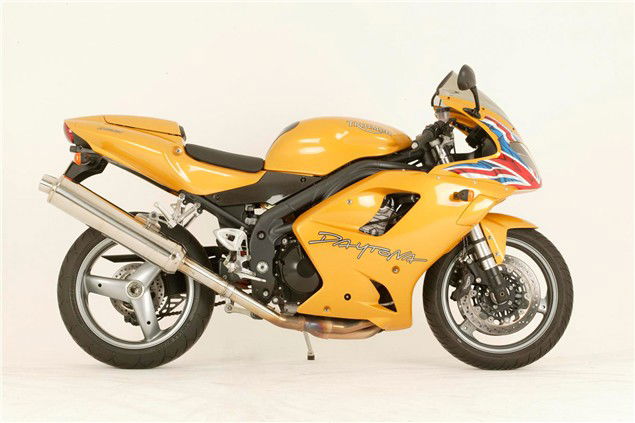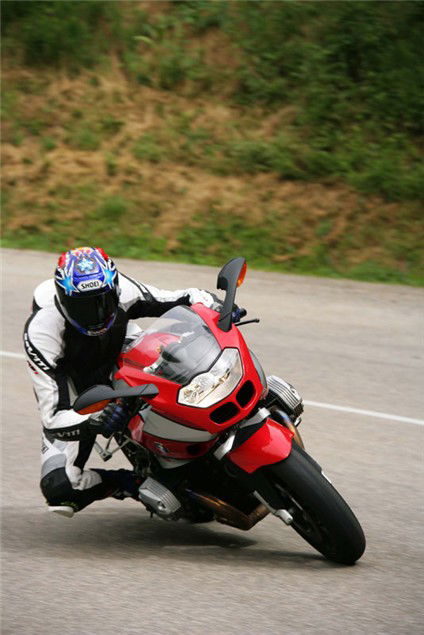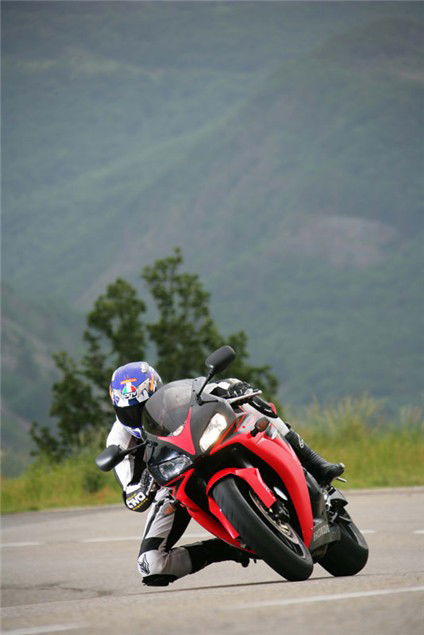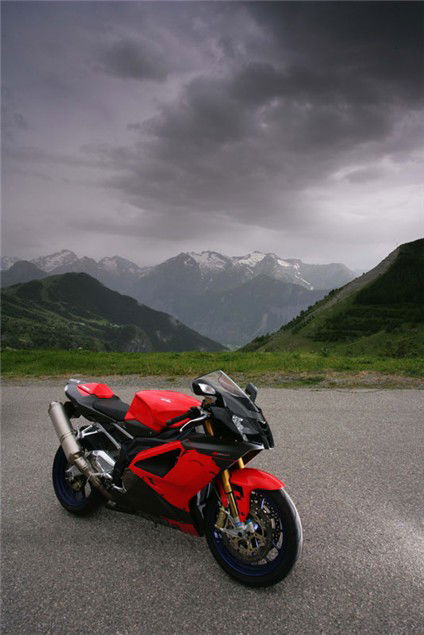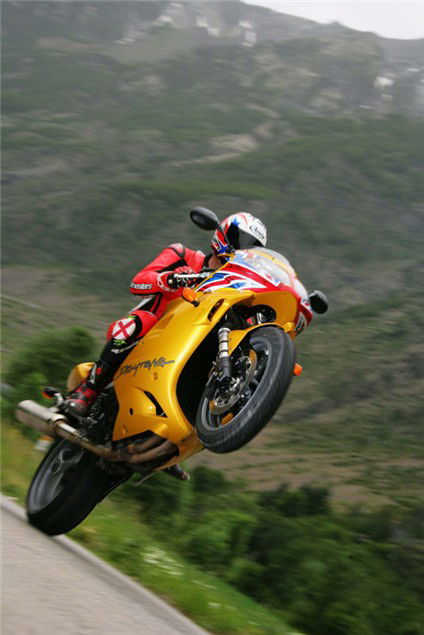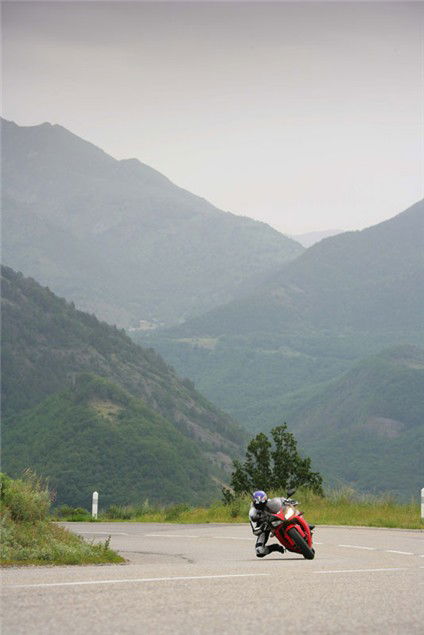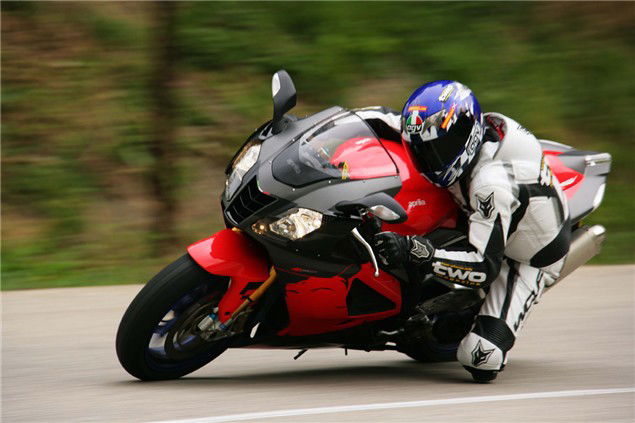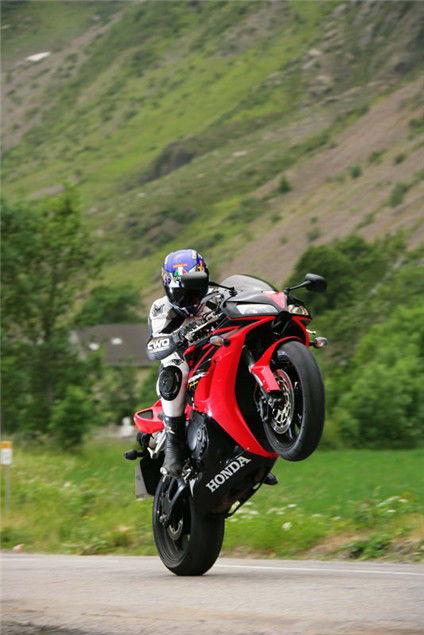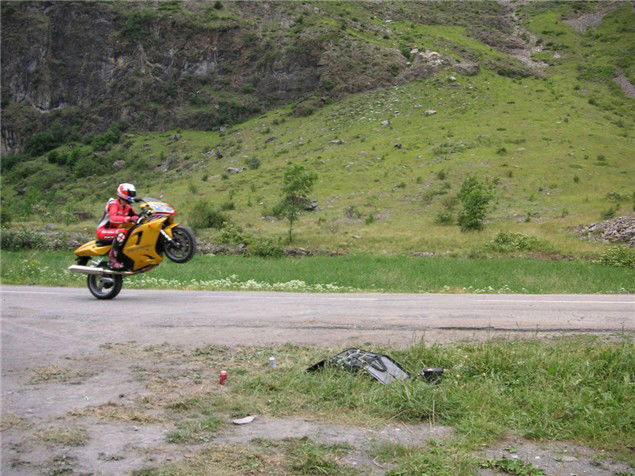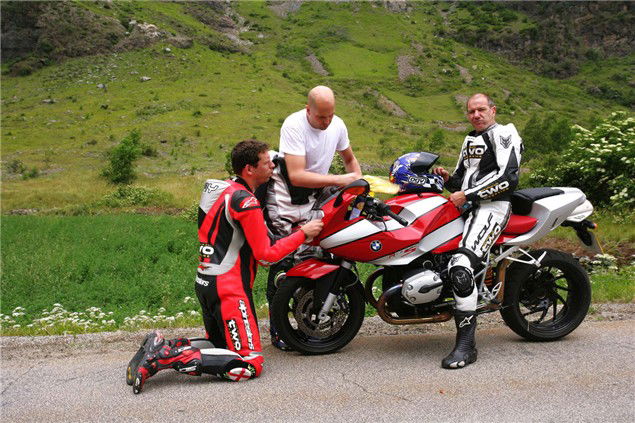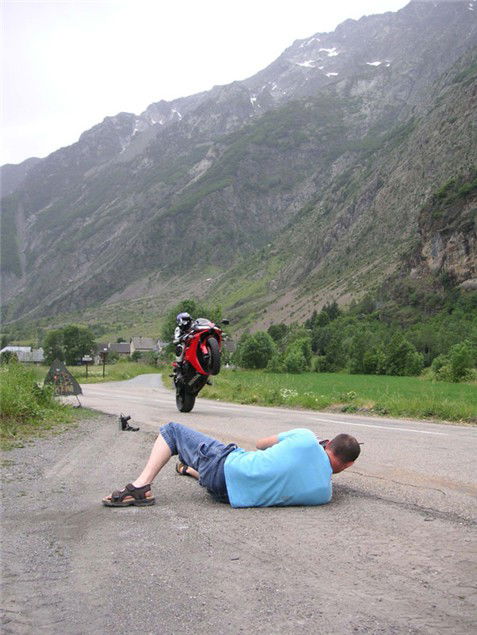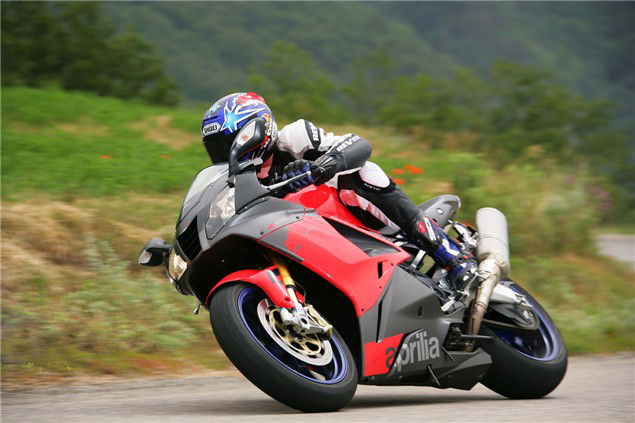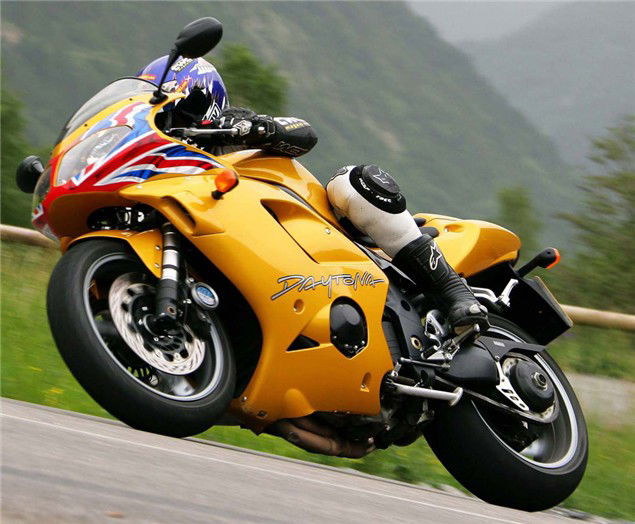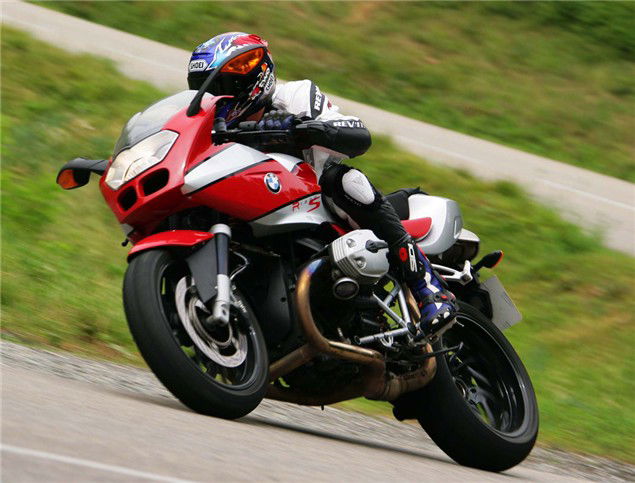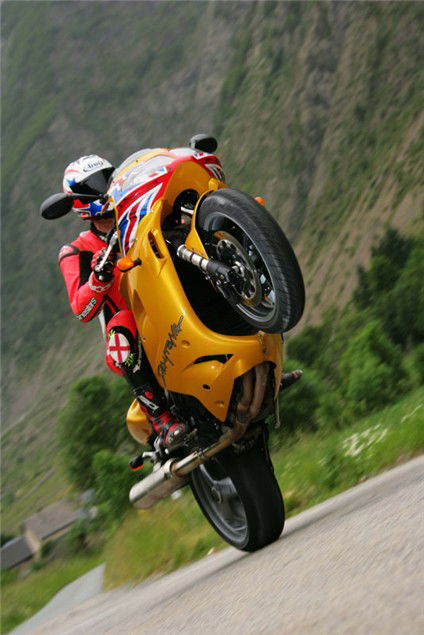Road Test: R1200S v. RSV-R v. CBR1000RR v. 955i
BMW wants us to know their new R1200S is very much a sports bike. But by whose reckoning? Theirs or ours? Sporting all-sorts go to the Alps to find out. And not a race track in sight...

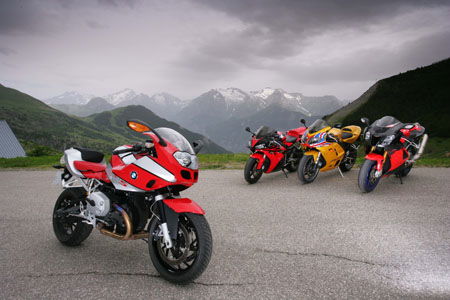 |
There's more to motorcycling than sports bikes, but here in the UK the sales charts of new machines continue to be topped by sports-focused tools. Everyone's got one, from Aprilia to Yamaha and, for the most part, they sell bucket loads. Sports bikes have another use too: people race them, and success on the track is intrinsic to sales of that particular firm's models - not just the ones seen winning races on the telly.
Except most of us don't ride on race tracks most of the time, and while many of us may buy sports bikes to live out fantasies of Rossi-esque superstardom on sunny Sunday mornings before lunch, the reality is we actually want our sports bikes to be much more than one-trick wonders. A bit of practicality here and some usability there goes a long way. What we're looking for is a, er, 'real world' sports bike, if such a thing exists.
So here's BMW's new R1200S. Launched earlier this year, on road and track, to an, 'It's a sports bike!' fanfare, the 1200S is the long awaited replacement for the R1100S. In line with the revamp dished out to the R1200GS and RT, the S gets the lighter, punchier, 1170cc Boxer motor, a 13-kilo loss in weight and nearly funky new styling to go with the £8955 price tag for the basic bike.
But once again BMW is choosing to carve its own niche; the R1200S is a sports bike within the context of BMW's penchant for doing things its own way. Wander over to the firm's website and you'll find them stamping their feet, proclaiming, 'Sport, sport, sport!'. 'Yeah, right,' scoffs the Fireblade/GSX-R/R1/ ZX-10R massive, 'course it is...' But look closer and you'll see where BMW is coming from: 'Sporty like no other flat twin before it... ', 'Moving in the direction of sporty riding... '. A candidate for racing success the R1200S may not be, but as far as BMW's range of Boxer twins go, this is very much a sports bike.
Had we been of the mind we could, cynically and irrelevantly, have rocked up at a racetrack with an R1200S, a Blade, an R1 and the rest, had Mackenzie wazz round for a few laps on each, then laughed and pointed at the BMW. Too easy, too obvious and missing the point entirely.
Instead we chose a global cross-section of takes on the sports bike theme and headed off south-ish to the French Alps, via south London and Dover, then back to Blighty for speed and dyno testing, and home in time for Desperate Housewives to keep Niall happy.
| Step forward, then, the all-too obvious choice, Honda's slightly-revised-for-2006 Fireblade, yours for £8899. Neck-and-neck with the GSX-R1000 for all-out litre class sports bike honours, the pin sharp, always usable Blade comes with a snarling edge of added aggression this year thanks to lowered gearing and a shortened wheelbase (plus a few new insidey-engine bits and pieces). As a full-on sports bike the Honda rocks big time, but is as at home hooning round Donington on a track day as it is dealing with the morning commute or heading off across the water for a foreign blast. Representing the Italian way of doing things we have Aprilia's RSV-R. A perennial favourite among a hardcore of British sports bike fans, the Aprilia has long offered an affordable slice of evocative V-twin pie to those looking for some true Latin soul. Here in its best-looking guise yet, the basic RSV-R (the higher-spec Factory was deemed a step too far for this test) gets improved fuel injection, a handful more bhp and very shiny Ohlins forks, all for £8999. Triumph's 955i has been around for, oh, ever such a long time now. Itself billed as a 'Blade beater' in its day, the Daytona has since quietly got on with being a genuinely usable everyday all-round sports(ish) tool. Why 'ish'? Because the Triumph, while once knocking on the door of real sports bike contention, has plodded on as good as unchanged while pretty much everything around it has jumped on the technological bandwagon and cleared off into the distance. Cutting edge it ain't. Still, it's a lot of bike for just £7499. | 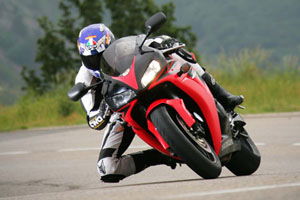 |
It says a lot for the gentle hum of speculation and hype surrounding the new R1200S that there was a genuine argument about who should get to ride it first when the bike arrived at the office. Everyone was asking: "What's it like?" And it's like... a BMW. More specifically, it's like a Boxer BMW. That means you have the combination of flat twin power and the weirdly un-involving sensations delivered by the front Telelever and rear Paralever suspension. At this point, 'cos it's as good as any, we should point out that our bike came fitted with a few optional extras, as is often the way with BMW press fleet machines. Ours had heated grips and the £450 'sports pack', which meant an …hlins shock, larger six-inch rear rim and 190/55 rear tyre (180/55 is standard). It also came with switch-offable ABS, which adds another £650. All-in, it would chime the till at £10,320.
So anyway. Step back, take in what you're looking at. It's no beauty, but in many ways chunkily, almost brutally handsome. The paint scheme, with a design nicked off the Tirpitz, is better in pictures than the flesh, but on the whole the look appeals. I think. "So ugly it's cool," reckoned John Hogan. Yes, that's it.
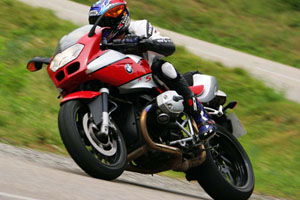 | Big, too. Wide and long more than anything, and there's something about the Telelever front end that gives a sensation of weight that isn't there, a kind of artificial impression of mass leading to a reassuring stability. Blasting down the autoroute to Grenoble the BMW was by far and away the most stable of our four. But it's a weird kind of stability; hold a line and it feels rock solid, glued to the spot as if nothing will budge it off line. But nudge the bars to change lane or tip into another 130mph slip road sweeper and the BMW is pinpoint accurate and strangely responsive. And I think that's what got me all confused: the R1200S is pretty quick steering, and it is accurate, and it will hold any line it's pointed at, but before, during and after the act the feedback from the wacky Telelever front end and Paralever rear is either non-existent or so alien that I haven't yet worked out what the bike is telling me. And that's kind of off-putting. It works, but not in the way I'm used to, despite many miles trying. Ride one of these all the time and you'll know no difference; jump from an R1200S to anything else and back again, and again, and it's all a bit confusing. |
The motor is less confusing. The punchy twin delivers its kick with a flat, rasping burble. Down low the power is accessible and useful; spin it up hard and it's far from slow, but just as things really get going you find yourself at the redline. However, you'll pay for that turn of speed with two hands full of vibes. Despite its recent revamp the motor still feels dated, but it's crisp enough and fuels smoothly.
Up in the twists and turns of the French Alps the BMW was enjoyable and entertaining, even flattering - pick the right line and it'll hold it inch perfect; pick the wrong one though and it'll hold that too - but again it takes getting used to. Again this sensation of weight that isn't there plays a part. The BMW feels solid and secure, the Fireblade and Aprilia are nimble and nervous. Where a bumpy road will upset the RSV-R and have the Fireblade's clever HESD anti-slap facility working full pelt, the BMW just kind of clatters over and through bumps. There's quite a lot of fore and aft weight transfer, and the shaft's torque reaction gets involved too so the ride can be unnerving if you really push on, but again the suspension gives different signals to those that we're used to. The other thing you have to get used to is not changing down too quickly into hairpins and the like - clunk down to first too early and the back end locks, skips and hops from side to side in your wake. A more measured approach is needed, with down-changes left until the last possible moment. Riding this bike quickly takes a bit more thought. It is possible to go very, very fast on twisting, unfamiliar roads on the BMW - you're just never sure that you should.
The Fireblade is the antithesis of all this. It is so capable, the chassis so sharp, the engine is so fast, the suspension so controlled, that it can suck you in to going way too fast. It's pure sports in that it makes going too quick far too easy.
"1000cc sports bikes are no longer scary, uncontrollable beasts," said Urry. "The Fireblade is a civilised bike that's the easiest to hop on and get on with the job." Even - or especially - if that job is going ballistic.
| The motor is sublime. Creamy smooth, instantly accessible power from bottom to top with crisp fueling, it is perfectly mated to the chassis. Jumping from the Beemer to this after fueling up on the autoroute, accelerating out of the service station slip road was like being fired from a cannon. But much more fun. Lacking soul it may be, but you can't deny that the Blade is one slick, refined package. Each part works in harmony with the other in a way that's almost too good. There's nothing to distract you from getting on with riding, and perhaps that's why the Honda is accused of lacking character. It's also why you find yourself going too damn fast a lot of the time. Even in the wet, or on the bumpiest, crumbliest of Alpine roads, the near excess of power is usable and controllable. You certainly get your money's worth, because while the Honda does all this on the road, it's also able to cut it on track fresh from the crate. What impresses most is the Honda's versatility. However you feel like riding at the time, the Blade will cope without batting an eyelid. Bleary-eyed morning commute through town? No problem. Manic, one-hundred-and-stupid-mph motorway blast? Easy. Twisting mountain thrash? Just the ticket. | 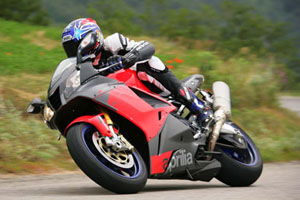 |
Aprilia's RSV-R is more of a thoroughbred, without the Honda's refined concessions to day-to-day use. The riding position is more uncompromising, with low bars and high, cramped pegs, while the seat is firm and unforgiving. The screen is low, flat and not much use unless your chin is on the tank, but it all looks so good. Stunning, in fact.
As a pure sports bike the RSV-R initially feels like it would have the edge over the Honda simply because it feels less at home doing the things the Fireblade takes in its stride; trickling through traffic is more awkward, motorways less comfortable, but on the right roads the Aprilia is nearly stunning. 'Nearly' because the motor lets it down by feeling a bit flat in the top quarter of the rev range, just where you're looking for a bit of over-rev to keep hold of that punchy V-twin drive from the midrange and below. Niall reckoned it could do with some free-breathing pipes to let the motor sing; I'm pretty sure the gearing is a touch on the high side, with too tall upper ratios letting the 60-degree lump drop out of the power on the upchange. Maybe a small change in sprocket sizes would reap some rewards.
But anyway, it's still involving and rewarding. The motor's free-revving low-down donk-donk-donk builds to a unique, almost plasticky-sounding hammer drill crescendo towards the top of the range in the lower gears, only muted as speed really builds and noisy windblast from the low screen takes over.
It handles, too. At low speed it's manageable enough, but once shifting the Aprilia is nervously nimble and responsive without ever getting out of shape. Every now and then it feels like it might be thinking about it, but it never happened. Not with us, anyway. Really nadgery mountain roads and pot-holed, oil-stained hairpins aren't really its thing, but faster, flowing, sweeping bends are devoured with ease. Brakes are excellent too, and complemented superbly by the …hlins forks. Where the Blade's Nissin stoppers are almost too sharp if you're not thinking about what you're doing or you grab a handful in a panic, the RSV-R's Brembos mate mighty stopping power with real control. Shame the back brake didn't work, and the clutch got all grabby. Seems some things never change...
And then there's the Triumph. There was a time, back in 2000 I think, when an earlier incarnation of Triumph's 955cc, three-cylinder sports bike was nearly on a par with Honda's Fireblade. The Triumph really wasn't far off and that was some achievement. Since then though the Daytona has, in many people's eyes, slipped comfortably into the role of sports tourer with no loss of dignity or credibility.
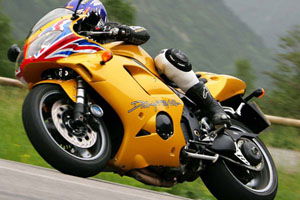 | But it's still a sports bike at heart. Trouble is everything else is now leagues ahead while the Daytona has stagnated. Visually, ergonomically and stylistically the Triumph shows its age. "It just feels old," said Urry and Hogan. And it does. The seat feels low, the screen is high and the bars are a long way off. Comfortable though, and roomy enough for even tall types to have a stretch about and knock out big miles with relative ease. In fact this is one long-legged mile eater. Fifth and sixth gear ratios are sky high - first time on the Triumph on the autoroute I thought I was cruising along in top only to toe the lever up by chance and find another gear to go. And another. But the rorty triple motor has the grunt to pull it, with a fluid, elastic power delivery - not to mention a superb noise - that propels the bike forward with real urgency in the lower gears. Providing you can make the shift from first to second, that is. Apparently the Daytona's gearbox has been revised this year but something was not right with our machine. Cogging up from first to second often resulted in a noise that sounded like, "a bag of spanners being kicked down some stairs," according to Urry. Nearly a neutral but not quite, the box would then drop into second and back to normal. "It's a shame," continued Urry. "The bike's not bad, the engine is lovely and smooth and surprisingly fast, and the chassis is okay. But it just feels old." |
And the chassis is okay. It feels like it's got, or perhaps had, some real potential, but it's simply too soft. Soft enough to dull the steering, pitch the bike back and forward on the brakes and under acceleration, and induce a mild weave at sustained speed. Up in the mountains the Daytona was the least adept, the least involving and the least fun to ride. Where the BMW tracked straight and true, and the Aprilia and Honda were sports bike sharp, the Triumph wandered about of its own accord until pulled back in line. "Oi, you, back over here..."
While the Triumph won plaudits on this test I failed to really gel with it. I think a lot of that is Triumph's own fault. With bikes such as the Sprint ST, Speed Triple and 675 Daytona we know Triumph is capable of moving forward and building blinding motorcycles in a unique, modern mould. But the 955i has been left behind. It's still a cracking tool in many respects. The motor is a peach, it's comfortable and, with some suspension fiddling, handles okay. It's not a sports bike in the contemporary sense but when Niall and Jon had to pick of two of the four bikes for the ride home, they opted for the Fireblade and the Daytona. And that says something.
Predictably, the Honda stood proud as the most focused yet all-round usable bike, and, I guess, the one I'd end up buying if I had to pick a tool to best suit my needs. That's my needs, mind, maybe not yours. "Inspiring, reassuring and effective," reckoned Hogan, "and so much more fun than the other bikes on this test."
The Blade is slick and polished and just as happy in the Alps as it is almost anywhere else, and with a bit of nasty aggression re-injected into the mould for 2006, the Honda lights my fire again.
But so did the Aprilia. In fact, I was really taken by it. I think we all were. "It offers real value for money," said Urry. "The motor is lovely and the handling really very good." And he's right, it's quite a package, and a stunning looking one at that. Not sure if I'd be so keen on spending too much time on it in traffic on a hot summer's day though, slow-roasting my nads with the heat from the rear cylinder, but on the whole the RSV-R is an impressive, sexy-looking package with real credibility.
The BMW really got under my skin. A couple of times on our trip I had the pick of four bikes for an hour-long blast through superb Alpine roads to get to or from a photo location. Each time I took the BMW. Sitting here now I want to ride it again. But I think - although I'm not sure - that if I owned one I would be frustrated by its limitations and idiosyncrasies as much as I would be entertained by its abilities. But like I said, I'm not sure. Every now and then I like to cut loose on a track day, and the Blade or RSV-R would be much more adept at that. On track I want to know a bike has performance - that's engine, chassis and brakes - to spare, and then some. The Blade and RSV-R have that. And while the Aprilia is focused and not a little uncomfortable day-to-day, the Blade packs the BMW's all-round ability while also offering real race track potential.
No, the R1200S is not a sports bike in the Japanese four or Italian V-twin sense, but it is a capable, appealing and likeable... sports tourer? No. All-rounder? Nope. It's... oh sod it, it's just a motorbike, like the rest of 'em.
MOUNTAIN EXCITEMENT
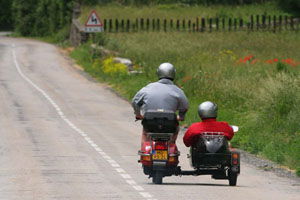 | Our destination, Grenoble, on the western tip of the French Alps, is an easy-ish 550-mile day's ride from Calais. It's ace biking territory, with the Alps to the east and the N85 Route de Napoleon running through the town (although that road is at its best some way to the south past Gap). Up in the mountains there's stunning riding to be had, with roads such as the N91 and N6 running east-westish between the larger peaks, and the crumbling, sometimes terrifying passes running over the Cols. Be warned, it'll be busy at this time of year with hordes of two-wheelers, both pedal-powered and motorised, making the best of the roads and scenery. It can be challenging riding too, so have your wits about you. But before we got there we had to get there, so which of our four got top honours for the long haul? I was expecting the BMW to rule on the journey down, what with the firm's touring heritage. Except BMW is most definitely not touting the R1200S as a tourer - to the point that panniers are not an official option (but you can have heated grips). Forgive me if I'm stereotyping here, but I reckon even the sportiest of diehard BMW buyers will hanker after panniers every now and then, and by not offering them BMW could be excluding some otherwise dead-cert buyers. |
Conversely, people won't buy an R1200S over a Fireblade simply because the Beemer doesn't have a hard luggage option. It's making a point for the sake of it, which could backfire. The Beemer is comfortable, but the killer over distance are the vibes from the motor. By the end of one fast stint I couldn't tell where my fingers finished and the handlebars started. At lower speeds it's not so bad, but the vibes are still there. On the plus side the BMW was rock solid stable at any speed. The Aprilia was probably the least well suited to our long distance blast. A low screen and cramped riding position with high pegs were uncomfortable for racer-sized Niall, never mind 6ft 2in me (although Hogan claimed to be quite at home on it), but the thing that really made our blood boil, quite literally, was the heat from the rear cylinder, which turned the seat into a frying pan. Even at speed it was necessary to stand up every now and then for added air-cooling. Apart from a mild weave and vagueness at speed, Triumph's Daytona was equal best long distance tool. It may look old hat when you're sat on board but the fairing protects better than any other here, the seat is comfy and the high-geared motor flexible and pleasing to use. A 20-litre tank and fuel consumption well into the 40s at sustained speed means you've got a handy near 180-mile range too. And there's lots of underseat storage. Annoyingly (because you just want it to do something badly), the Honda was as good as anything on the trip down. Comfortable-ish, decent-ish range, bearable wind protection and if it got too much you've got all that horsepower to play with to take your mind off things. All bikes had plastic tanks so magnetic bags were out, but tailpacks fitted securely - although we'd have been better off with pillion seat pads, not plastic single seat covers. | |
| NIALL'S SECOND OPINION - BMW | |
"I first jumped on the R1200S at one of the Autoroute fuel stops after 250 miles on the Triumph. After re-joining the motorway I was immediately impressed with how pin sharp the handling was, particularly at high speed. Changing lanes and 120mph sweepers were much easier on the loftiest of the four bikes. Our bike had the …hlins rear shock option, which also gave a plusher feel over bumpy roads, but being a tall, heavy bike slow speed manoeuvring is always tricky. Nevertheless, I'd say the …hlins suspension would be a worthwhile box to tick on the options list. There's very little protection from the elements on the big twin but it is, after all, a sports bike and not a tourer. Even on short stretches of motorway the speedo would go straight to 150mph, although it did use high rpm and nearly all the throttle travel in the process. All BMWs are a break from the norm and I have to say as every day passed this bike's looks, engine and handling grew on me big time." | 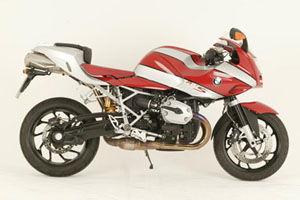 |
| NIALL'S SECOND OPINION - HONDA | |
"For me the Honda was equal first with the Triumph at covering distance on the trip down, which isn't bad considering you would be equally as comfortable blitzing round Donington Park on it on a track day. Honda is all about perfection, which is not for everyone, but I can't help being impressed with this latest Blade. It was as happy pottering through French villages as it was at 160mph on the motorway [that's the private motorway Niall's got in his garden - Tim]. It also gives positive feedback whatever your ability or experience, keeping the job safe. The only downside was that at times it inspired too much confidence. The suspension, electronic steering damper and brakes are so good I often found myself travelling way too fast. But whatever you throw at this bike it delivers the goods with ease. At this point I normally drop in a few negatives but I'm struggling. Alright, it hasn't won any superstock races, but this is still one incredibly versatile motorcycle." | 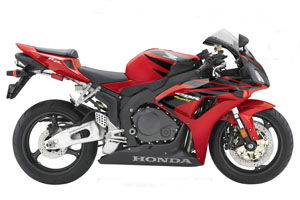 |
| NIALL'S SECOND OPINION - TRIUMPH | |
"I like the frame and I like the engine, but everything else about this bike needs some serious updating. Features that should be pleasing on the eye, like the exhaust and the dash, are well and truly stuck in the 90s, so unfortunately turn me right off this bike. Sorry, but that kind of thing is important to me. I'm not panicking however, because with stylish beauties like the 675 Daytona and Speed Triple emerging from Hinckley recently, hopefully the next 955 will benefit from the same treatment. Apart from a slightly sloppy gear change there is not a lot wrong with the motor. I never got bored with the bark of the big triple whether I was cruising at 120mph or blasting through the mountain roads above Grenoble. Apart from a minor weave at high speed the handling was fine, plus the comfy riding position and soft seat meant I chose the Triumph for the long ride home. It is still a very capable bike, but the competition now looks more desirable." | 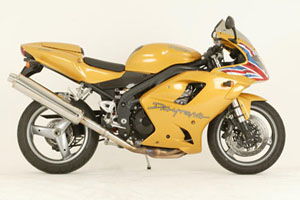 |
| NIALL'S SECOND OPINION - APRILIA | |
| "I have to give Aprilia top marks for giving us the best-looking RSV-R so far. It's a bike with great attention to detail; small touches like the unusual tank and dash fasteners, Ohlins forks, Brembo brakes, the nicely engineered top yoke and neat foot pegs make this 1000cc V-twin really stand out from the crowd. Even the black plastic dash looks good. The 60-degree engine is my favourite V-twin in a sports bike, but it does feel like it needs to be de-strangled with some decent aftermarket exhausts - it just feels a bit flat at higher rpm. As a track day toy and for the odd 100-mile run I think the RSV-R is hard to beat, but the high and forward foot pegs almost killed me on our long journey through France. Some fellow testers have questioned RSV-R reliability in the past but personally I've never encountered any problems. Sorting out the riding position would be an absolute must for me, but otherwise I thought the RSV-R was first class." | 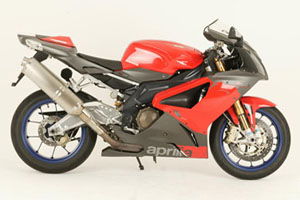 |
| SPECS - APRILIA TYPE - SUPERSPORTS PRODUCTION DATE - 2006 PRICE NEW - £8999 ENGINE CAPACITY - 997cc POWER - 122.1bhp@9900rpm TORQUE - 67.2lb.ft@8300rpm WEIGHT - 189kg SEAT HEIGHT - 820mm FUEL CAPACITY - 17L TOP SPEED - 165.7mph 0-60 - n/a TANK RANGE - 150MILES | SPECS - BMW TYPE - SUPERSPORTS PRODUCTION DATE - 2006 PRICE NEW - £10,320 ENGINE CAPACITY - 1170cc POWER - 111.5bhp@8000rpm TORQUE - 76.6lb.ft@6800rpm WEIGHT - 190kg SEAT HEIGHT - 830mm FUEL CAPACITY - 17L TOP SPEED - 151mph 0-60 - n/a TANK RANGE - 150MILES | SPECS - HONDA TYPE - SUPERSPORTS PRODUCTION DATE - 2006 PRICE NEW - £8899 ENGINE CAPACITY - 998cc POWER - 157.6bhp@11,300rpm TORQUE - 79.6lb.ft@8700rpm WEIGHT - 176kg SEAT HEIGHT - 831mm FUEL CAPACITY - 18L TOP SPEED - 176.9mph 0-60 - n/a TANK RANGE - 120MILES | SPECS - TRIUMPH TYPE - SUPERSPORTS PRODUCTION DATE - 2006 PRICE NEW - £7499 ENGINE CAPACITY - 955cc POWER - 136.7bhp@10,600rpm TORQUE - 70lb.ft@8700rpm WEIGHT - 191kg SEAT HEIGHT - 815mm FUEL CAPACITY - 20L TOP SPEED - 163.2mph 0-60 - n/a TANK RANGE - 180MILES |

BMW wants us to know their new R1200S is very much a sports bike. But by whose reckoning? Theirs or ours? Sporting all-sorts go to the Alps to find out. And not a race track in sight...
There's more to motorcycling than sports bikes, but here in the UK the sales charts of new machines
continue to be topped by sports-focused tools. Everyone's got one, from Aprilia to Yamaha and, for the most part, they sell bucket loads. Sports bikes have another use too: people race them, and success on the track is intrinsic to sales of that particular firm's models - not just the ones seen winning races on the telly.
Except most of us don't ride on race tracks most of the time, and while many of us may buy sports bikes to live out fantasies of Rossi-esque superstardom on sunny Sunday mornings before lunch, the reality is we actually want our sports bikes to be much more than one-trick wonders.
A bit of practicality here and some usability there goes a long way. What we're looking for is a, er, 'real world' sports bike, if such a thing exists. So here's BMW's new R1200S. Launched earlier this year, on road and track, to an, 'It's a sports bike!' fanfare, the 1200S is the long awaited replacement for the R1100S. In line with the revamp dished out to the R1200GS and RT, the S gets the lighter, punchier, 1170cc Boxer motor, a 13-kilo loss in weight and nearly funky new styling to go with the £8955 price tag for the basic bike.
But once again BMW is choosing to carve its own niche; the R1200S is a sports bike within the context of BMW's penchant for doing things its own way. Wander over to the firm's website and you'll find them stamping their feet, proclaiming, 'Sport, sport, sport!'. 'Yeah, right,' scoffs the Fireblade/GSX-R/R1/
ZX-10R massive, 'course it is...' But look closer and you'll see where BMW is coming from: 'Sporty like no other flat twin before it... ', 'Moving in the direction of sporty riding... '. A candidate for racing success the R1200S may not be, but as far as BMW's range of Boxer twins go, this is very much a sports bike.
Had we been of the mind we could, cynically and irrelevantly, have rocked up at a racetrack with an R1200S, a Blade, an R1 and the rest, had Mackenzie wazz round for a few laps on each, then laughed and pointed at the BMW. Too easy, too obvious and missing the point entirely.
Instead we chose a global cross-section of takes on the sports bike theme and headed off south-ish to the French Alps, via south London and Dover, then back to Blighty for speed and dyno testing, and home in time for Desperate Housewives to keep Niall happy.
Step forward, then, the all-too obvious choice, Honda's slightly-revised-for-2006 Fireblade, yours for £8899. Neck-and-neck with the GSX-R1000 for all-out litre class sports bike honours, the pin sharp, always usable Blade comes with a snarling edge of added aggression this year thanks to lowered gearing and a shortened wheelbase (plus a few new insidey-engine bits and pieces). As a full-on sports bike the Honda rocks big time, but is as at home hooning round Donington on a track day as it is dealing with the morning commute or heading off across the water for a foreign blast.
Representing the Italian way of doing things we have Aprilia's RSV-R. A perennial favourite among a hardcore of British sports bike fans, the Aprilia has long offered an affordable slice of evocative
V-twin pie to those looking for some true Latin soul. Here in its best-looking guise yet, the basic RSV-R (the higher-spec Factory was deemed a step too far for this test) gets improved fuel injection, a handful more bhp and very shiny Öhlins forks, all for £8999.
Triumph's 955i has been around for, oh, ever such a long time now. Itself billed as a 'Blade beater' in its day, the Daytona has since quietly got on with being a genuinely usable everyday all-round sports(ish) tool. Why 'ish'? Because the Triumph, while once knocking on the door of real sports bike contention, has plodded on as good as unchanged while pretty much everything around it has jumped on the technological bandwagon and cleared off into the distance. Cutting edge it ain't. Still, it's a lot of bike for just £7499.
It says a lot for the gentle hum of speculation and hype surrounding the new R1200S that there was a genuine argument about who should get to ride it first when the bike arrived at the office. Everyone was asking: "What's it like?" And it's like... a BMW. More specifically, it's like a Boxer BMW. That means you have the combination of flat twin power and the weirdly un-involving sensations delivered by the front Telelever and rear Paralever suspension. At this point, 'cos it's as good as any, we should point out that our bike came fitted with a few optional extras, as is often the way with BMW press fleet machines. Ours had heated grips and the £450 'sports pack', which meant an Öhlins shock, larger six-inch rear rim and 190/55 rear tyre (180/55 is standard). It also came with switch-offable ABS, which adds another £650. All-in, it would chime the till at £10,320.
SPECS - BMW R1200S
TYPE - SUPERSPORTS
PRODUCTION DATE - 2006
PRICE NEW - £10,320
ENGINE CAPACITY - 1170cc
POWER - 111.5bhp@8000rpm
TORQUE - 76.6lb.ft@6800rpm
WEIGHT - 190kg
SEAT HEIGHT - 830mm
FUEL CAPACITY - 17L
TOP SPEED - 151mph
0-60 - n/a
TANK RANGE - 150MILES
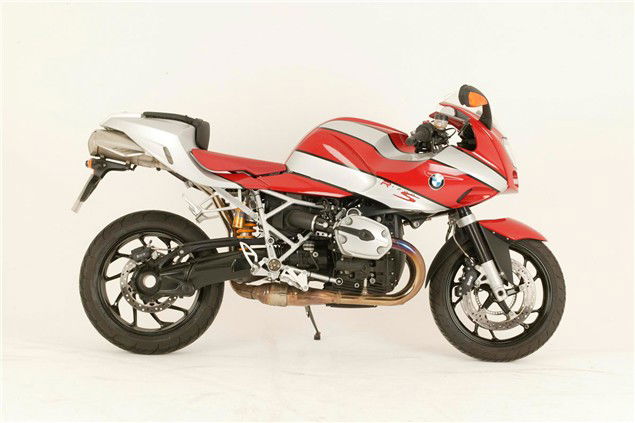
So anyway. Step back, take in what you're looking at. It's no beauty, but in many ways chunkily, almost brutally handsome. The paint scheme, with a design nicked off the Tirpitz, is better in pictures than the flesh, but on the whole the look appeals. I think. "So ugly it's cool," reckoned John Hogan. Yes, that's it.
Big, too. Wide and long more than anything, and there's something about the Telelever front end that gives a sensation of weight that isn't there, a kind of artificial impression of mass leading to a reassuring stability.
Blasting down the autoroute to Grenoble the BMW was by far and away the most stable of our four. But it's a weird kind of stability; hold a line and it feels rock solid, glued to the spot as if nothing will budge it off line. But nudge the bars to change lane or tip into another 130mph slip road sweeper and the BMW is pinpoint accurate and strangely responsive. And I think that's what got me all confused: the R1200S is pretty quick steering, and it is accurate, and it will hold any line it's pointed at, but before, during and after the act the feedback from the wacky Telelever front end and Paralever rear is either non-existent or so alien that I haven't yet worked out what the bike is telling me. And that's kind of off-putting.
It works, but not in the way I'm used to, despite many miles trying. Ride one of these all the time and you'll know no difference; jump from an R1200S to anything else and back again, and again, and it's all a bit confusing.
The motor is less confusing. The punchy twin delivers its kick with a flat, rasping burble. Down low the power is accessible and useful; spin it up hard and it's far from slow, but just as things really get going you find yourself at the redline. However, you'll pay for that turn of speed with two hands full of vibes. Despite its recent revamp the motor still feels dated, but it's crisp enough and fuels smoothly.
Up in the twists and turns of the French Alps the BMW was enjoyable and entertaining, even flattering - pick the right line and it'll hold it inch perfect; pick the wrong one though and it'll hold that too - but again it takes getting used to.
Again this sensation of weight that isn't there plays a part. The BMW feels solid and secure, the Fireblade and Aprilia are nimble and nervous. Where a bumpy road will upset the RSV-R and have the Fireblade's clever HESD anti-slap facility working full pelt, the BMW just kind of clatters over and through bumps. There's quite a lot of fore and aft weight transfer, and the shaft's torque reaction gets involved too so the ride can be unnerving if you really push on, but again the suspension gives different signals to those that we're used to. The other thing you have to get used to is not changing down too quickly into hairpins and the like - clunk down to first too early and the back end locks, skips and hops from side to side in your wake. A more measured approach is needed, with down-changes left until the last possible moment. Riding this bike quickly takes a bit more thought. It is possible to go very, very fast on twisting, unfamiliar roads on the BMW - you're just never sure that you should.
The Fireblade is the antithesis of all this. It is so capable, the chassis so sharp, the engine is so fast, the suspension so controlled, that it can suck you in to going way too fast. It's pure sports in that it makes going too quick far too easy.
"1000cc sports bikes are no longer scary, uncontrollable beasts," said Urry. "The Fireblade is a civilised bike that's the easiest to hop on and get on with the job." Even - or especially - if that job is going ballistic.
The motor is sublime. Creamy smooth, instantly accessible power from bottom to top with crisp fueling, it is perfectly mated to the chassis. Jumping from the Beemer to this after fueling up on the autoroute, accelerating out of the service station slip road was like being fired from a cannon. But much more fun.
Lacking soul it may be, but you can't deny that the Blade is one slick, refined package. Each part works in harmony with the other in a way that's almost too good. There's nothing to distract you from getting on with riding, and perhaps that's why the Honda is accused of lacking character. It's also why you find yourself going too damn fast a lot of the time. Even in the wet, or on the bumpiest, crumbliest of Alpine roads, the near excess of power is usable and controllable. You certainly get your money's worth, because while the Honda does all this on the road, it's also able to cut it on track fresh from the crate.
SPECS - APRILIA RSV-R
TYPE - SUPERSPORTS
PRODUCTION DATE - 2006
PRICE NEW - £8999
ENGINE CAPACITY - 997cc
POWER - 122.1bhp@9900rpm
TORQUE - 67.2lb.ft@8300rpm
WEIGHT - 189kg
SEAT HEIGHT - 820mm
FUEL CAPACITY - 17L
TOP SPEED - 165.7mph
0-60 - n/a
TANK RANGE - 150MILES
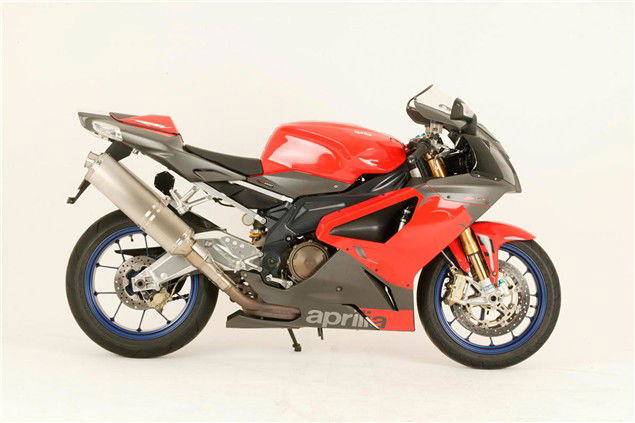
What impresses most is the Honda's versatility. However you feel like riding at the time, the Blade will cope without batting an eyelid. Bleary-eyed morning commute through town? No problem. Manic, one-hundred-and-stupid-mph motorway blast? Easy. Twisting mountain thrash? Just the ticket.
Aprilia's RSV-R is more of a thoroughbred, without the Honda's refined concessions to day-to-day use. The riding position is more uncompromising, with low bars and high, cramped pegs, while the seat is firm and unforgiving. The screen is low, flat and not much use unless your chin is on the tank, but it all looks so good. Stunning, in fact.
As a pure sports bike the RSV-R initially feels like it would have the edge over the Honda simply because it feels less at home doing the things the Fireblade takes in its stride; trickling through traffic is more awkward, motorways less comfortable, but on the right roads the Aprilia is nearly stunning. 'Nearly' because the motor lets it down by feeling a bit flat in the top quarter of the rev range, just where you're looking for a bit of over-rev to keep hold of that punchy V-twin drive from the midrange and below. Niall reckoned it could do with some free-breathing pipes to let the motor sing; I'm pretty sure the gearing is a touch on the high side, with too tall upper ratios letting the 60-degree lump drop out of the power on the upchange. Maybe a small change in sprocket sizes would reap some rewards.
But anyway, it's still involving and rewarding. The motor's free-revving low-down donk-donk-donk builds to a unique, almost plasticky-sounding hammer drill crescendo towards the top of the range in the lower gears, only muted as speed really builds and noisy windblast from the low screen takes over.
It handles, too. At low speed it's manageable enough, but once shifting the Aprilia is nervously nimble and responsive without ever getting out of shape. Every now and then it feels like it might be thinking about it, but it never happened. Not with us, anyway. Really nadgery mountain roads and pot-holed, oil-stained hairpins aren't really its thing, but faster, flowing, sweeping bends are devoured with ease. Brakes are excellent too, and complemented superbly by the Öhlins forks. Where the Blade's Nissin stoppers are almost too sharp if you're not thinking about what you're doing or you grab a handful in a panic, the RSV-R's Brembos mate mighty stopping power with real control. Shame the back brake didn't work, and the clutch got all grabby. Seems some things never change...
And then there's the Triumph. There was a time, back in 2000 I think, when an earlier incarnation of Triumph's 955cc, three-cylinder sports bike was nearly on a par with Honda's Fireblade. The Triumph really wasn't far off and that was some achievement. Since then though the Daytona has, in many people's eyes, slipped comfortably into the role of sports tourer with no loss of dignity or credibility.
But it's still a sports bike at heart. Trouble is everything else is now leagues ahead while the Daytona has stagnated. Visually, ergonomically and stylistically the Triumph shows its age. "It just feels old," said Urry and Hogan. And it does. The seat feels low, the screen is high and the bars are a long way off.
Comfortable though, and roomy enough for even tall types to have a stretch about and knock out big miles with relative ease. In fact this is one long-legged mile eater. Fifth and sixth gear ratios are sky high - first time on the Triumph on the autoroute I thought I was cruising along in top only to toe the lever up by chance and find another gear to go. And another. But the rorty triple motor has the grunt to pull it, with a fluid, elastic power delivery - not to mention a superb noise - that propels the bike forward with real urgency in the lower gears. Providing you can make the shift from first to second, that is. Apparently the Daytona's gearbox has been revised this year but something was not right with our machine. Cogging up from first to second often resulted in a noise that sounded like, "a bag of spanners being kicked down some stairs," according to Urry. Nearly a neutral but not quite, the box would then drop into second and back to normal. "It's a shame," continued Urry. "The bike's not bad, the engine is lovely and smooth and surprisingly fast, and the chassis is okay. But it just feels old."
And the chassis is okay. It feels like it's got, or perhaps had, some real potential, but it's simply too soft. Soft enough to dull the steering, pitch the bike back and forward on the brakes and under
acceleration, and induce a mild weave at sustained speed. Up in the mountains the Daytona was the least adept, the least involving and the least fun to ride. Where the BMW tracked straight and true, and the Aprilia and Honda were sports bike sharp, the Triumph wandered about of its own accord until pulled back in line. "Oi, you, back over here..."
While the Triumph won plaudits on this test I failed to really gel with it. I think a lot of that is Triumph's own fault. With bikes such as the Sprint ST, Speed Triple and 675 Daytona we know Triumph is capable of moving forward and building blinding motorcycles in a unique, modern mould. But the 955i has been left behind. It's still a cracking tool in many respects. The motor is a peach, it's comfortable and, with some suspension fiddling, handles okay. It's not a sports bike in the contemporary sense but when Niall and Jon had to pick of two of the four bikes for the ride home, they opted for the Fireblade and the Daytona. And that says something.
Predictably, the Honda stood proud as the most focused yet all-round usable bike, and, I guess, the one I'd end up buying if I had to pick a tool to best suit my needs. That's my needs, mind, maybe
not yours. "Inspiring, reassuring and effective," reckoned Hogan, "and so much more fun than the other bikes on this test."
The Blade is slick and polished and just as happy in the Alps as it is almost anywhere else, and with a bit of nasty aggression re-injected into the mould for 2006, the Honda lights my fire again. But so did the Aprilia. In fact, I was really taken by it. I think we all were. "It offers real value for money," said Urry. "The motor is lovely and the handling really very good." And he's right, it's quite a package, and a stunning looking one
at that. Not sure if I'd be so keen on spending too much time on it in traffic on a hot summer's day though, slow-roasting my nads with the heat from the rear cylinder, but on the whole the RSV-R is an impressive, sexy-looking package with real credibility.
The BMW really got under my skin. A couple of times on our trip I had the pick of four bikes for an hour-long blast through superb Alpine roads to get to or from a photo location. Each time I took the BMW. Sitting here now I want to ride it again. But I think - although I'm not sure - that if I owned one I would be frustrated by its limitations and idiosyncrasies as much as I would be entertained by its abilities. But like I said, I'm not sure. Every now and then I like to cut loose on a track day, and the Blade or RSV-R would be much more adept at that. On track I want to know a bike has performance - that's engine, chassis and brakes - to spare, and then some. The Blade and RSV-R have that. And while the Aprilia is focused and not a little uncomfortable day-to-day, the Blade packs the BMW's all-round ability while also offering real race track potential.
No, the R1200S is not a sports bike in the Japanese four or Italian V-twin sense, but it is a capable, appealing and likeable... sports tourer? No. All-rounder? Nope. It's... oh sod it, it's just a motorbike, like the rest of 'em.
SPECS - HONDA CBR1000RR FIREBLADE
TYPE - SUPERSPORTS
PRODUCTION DATE - 2006
PRICE NEW - £8899
ENGINE CAPACITY - 998cc
POWER - 157.6bhp@11,300rpm
TORQUE - 79.6lb.ft@8700rpm
WEIGHT - 176kg
SEAT HEIGHT - 831mm
FUEL CAPACITY - 18L
TOP SPEED - 176.9mph
0-60 - n/a
TANK RANGE - 120MILES
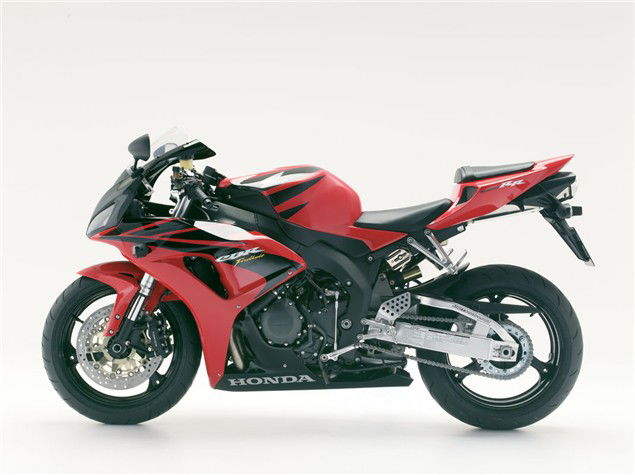
NIALL'S SECOND OPINION - BMW
"I first jumped on the R1200S at one of the Autoroute fuel stops after 250 miles on the Triumph. After
re-joining the motorway I was immediately impressed with how pin sharp the handling was, particularly at high speed. Changing lanes and 120mph sweepers were much easier on the loftiest of the four bikes. Our bike had the Öhlins rear shock option, which also gave a plusher feel over bumpy roads, but being a tall, heavy bike slow speed manoeuvring is always tricky.
Nevertheless, I'd say the Öhlins suspension would be a worthwhile box to tick on the options list. There's very little protection from the elements on the big twin but it is, after all, a sports bike and not a tourer. Even on short stretches of motorway the speedo would go straight to 150mph, although it did use high rpm and nearly all the throttle travel in the process.
All BMWs are a break from the norm and I have to say as every day passed this bike's looks, engine and handling grew on me big time."
NIALL'S SECOND OPINION - HONDA
"For me the Honda was equal first with the Triumph at covering distance on the trip down, which isn't bad considering you would be equally as comfortable blitzing round Donington Park on it on a track day.
Honda is all about perfection, which is not for everyone, but I can't help being impressed with this latest Blade. It was as happy pottering through French villages as it was at 160mph on the motorway [that's the private motorway Niall's got in his garden - Tim]. It also gives positive feedback whatever your ability or experience, keeping the job safe. The only downside was that at times it inspired too much confidence. The suspension, electronic steering damper and brakes are so good I often found myself travelling way too fast. But whatever you throw at this bike it delivers the goods with ease.
At this point I normally drop in a few negatives but I'm struggling. Alright, it hasn't won any superstock races, but this is still one incredibly versatile motorcycle."
NIALL'S SECOND OPINION - APRILIA
"I have to give Aprilia top marks for giving us the best-looking RSV-R so far. It's a bike with great attention to detail; small touches like the unusual tank and dash fasteners, Öhlins forks, Brembo brakes, the nicely engineered top yoke and neat foot pegs make this 1000cc V-twin really stand out from the crowd. Even the black plastic dash looks good.
The 60-degree engine is my favourite V-twin in a sports bike, but it does feel like it needs to be de-strangled with some decent aftermarket exhausts - it just feels a bit flat at higher rpm.
As a track day toy and for the odd 100-mile run I think the RSV-R is hard to beat, but the high and forward foot pegs almost killed me on our long journey through France. Some fellow testers have questioned RSV-R reliability in the past but personally I've never encountered any problems. Sorting out the riding position would be an absolute must for me, but otherwise I thought the RSV-R was first class."
NIALL'S SECOND OPINION - TRIUMPH
"I like the frame and I like the engine, but everything else about this bike needs some serious updating. Features that should be pleasing on the eye, like the exhaust and the dash, are well and truly stuck in the 90s, so unfortunately turn me right off this bike. Sorry, but that kind of thing is important to me. I'm not panicking however, because with stylish beauties like the 675 Daytona and Speed Triple emerging from Hinckley recently, hopefully the next 955 will benefit from the same treatment.
Apart from a slightly sloppy gear change there is not a lot wrong with the motor. I never got bored with the bark of the big triple whether I was cruising at 120mph or blasting through the mountain roads above Grenoble. Apart from a minor weave at high speed the handling was fine, plus the comfy riding position and soft seat meant I chose the Triumph for the long ride home. It is still a very capable bike, but the competition now looks more desirable."
MOUNTAIN EXCITEMENT
Our destination, Grenoble, on the western tip of the French Alps, is an easy-ish 550-mile day's ride from Calais. It's ace biking territory, with the Alps to the east and the N85 Route de Napoleon running through the town (although that road is at its best some way to the south past Gap). Up in the mountains there's stunning riding to be had, with roads such as the N91 and N6 running east-westish between the larger peaks, and the crumbling, sometimes terrifying passes running over the Cols. Be warned, it'll be busy at this time of year with hordes of two-wheelers, both pedal-powered and motorised, making the best of the roads and scenery. It can be challenging riding too, so have your wits about you.
But before we got there we had to get there, so which of our four got top honours for the long haul?
I was expecting the BMW to rule on the journey down, what with the firm's touring heritage. Except BMW is most definitely not touting the R1200S as a tourer - to the point that panniers are not an official option (but you can have heated grips). Forgive me if I'm stereotyping here, but I reckon even the sportiest of diehard BMW buyers will hanker after panniers every now and then, and by not offering them BMW could be excluding some otherwise dead-cert buyers.
Conversely, people won't buy an R1200S over a Fireblade simply because the Beemer doesn't have a hard luggage option. It's making a point for the sake of it, which could backfire. The Beemer is comfortable, but the killer over distance are the vibes from the motor. By the end of one fast stint I couldn't tell where my fingers finished and the handlebars started. At lower speeds it's not so bad, but the vibes are still there. On the plus side the BMW was rock solid stable at any speed.
The Aprilia was probably the least well suited to our long distance blast. A low screen and cramped riding position with high pegs were uncomfortable for racer-sized Niall, never mind 6ft 2in me (although Hogan claimed to be quite at home on it), but the thing that really made our blood boil, quite literally, was the heat from the rear cylinder, which turned the seat into a frying pan. Even at speed it was necessary to stand up every now and then for added air-cooling.
Apart from a mild weave and vagueness at speed, Triumph's Daytona was equal best long distance tool. It may look old hat when you're sat on board but the fairing protects better than any other here, the seat is comfy and the high-geared motor flexible and pleasing to use. A 20-litre tank and fuel consumption well into the 40s at sustained speed means you've got a handy near 180-mile range too. And there's lots of underseat storage.
Annoyingly (because you just want it to do something badly), the Honda was as good as anything on the trip down. Comfortable-ish, decent-ish range, bearable wind protection and if it got too much you've got all that horsepower to play with to take your mind off things.
All bikes had plastic tanks so magnetic bags were out, but tailpacks fitted securely - although we'd have been better off with pillion seat pads, not plastic single seat covers.
SPECS - TRIUMPH 955i DAYTONA
TYPE - SUPERSPORTS
PRODUCTION DATE - 2006
PRICE NEW - £7499
ENGINE CAPACITY - 955cc
POWER - 136.7bhp@10,600rpm
TORQUE - 70lb.ft@8700rpm
WEIGHT - 191kg
SEAT HEIGHT - 815mm
FUEL CAPACITY - 20L
TOP SPEED - 163.2mph
0-60 - n/a
TANK RANGE - 180MILES
